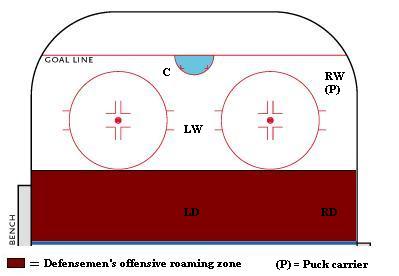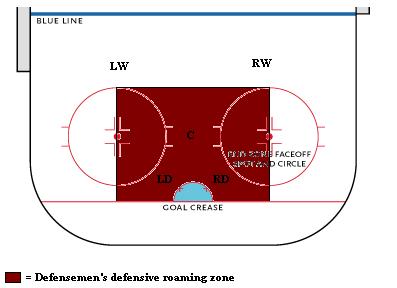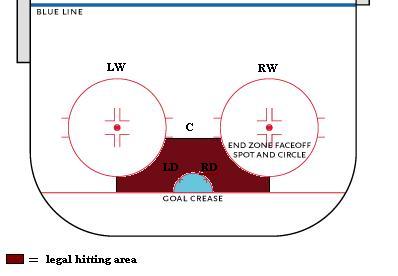

If there is anything rarer than seeing a human goalie between the pipes for an EASHL game, it is seeing two defensemen on the back line who do not:
1. Whine endlessly about being stuck in a position they do not want to play.
2. Give up a ton of scoring opportunities to the other team because they have no clue how to play the position.
But, if you are one of the few Bash Brothers out there, crack open an ice-cold drink mister lonely EASHL defenseman.
You will not feel lonely anymore!
For it is your careful positioning and timely stick lifts that keep the puck out of our net and keep the fear running through the veins of opposing forwards as they wonder where you are coming from with that next concussion-inducing body check.
Please, no more smelling salts!
Here is to you, safe keeper of the lost defensive art, always waiting for the referee's back to turn so you can hit that 5-foot-7-inch 150-pound dangler so hard that he can no longer feel his own dingle berries.
Mister lonely EASHL defenseman!
That is right Mr. Defensemen, believe it or not, you are actually the most important part of a hockey team next to the center.
Defense, Defense, Defense
The fact is, if you do not have any good defenders, your team is not going to be any good, either.
But what separates a good defenseman from a poor one, aside from his attitude when doing the team's dirty work?
This article is here to answer that question and explain all the skills you will need if you are ready to shoulder the responsibility of being one of the most influential players on the ice.
Positioning
More than anything, it is poor defensive positioning that most often results in goal-scoring opportunities for the opposing team. Whether that poor positioning occurs because defenders roam too deep into the offensive zone and give up breakaways at the other end of the ice, or because they simply chase puck carriers too far into the neutral zone is anybody's guess.
But, here are some handy visuals to help players see exactly where they should be spending most of their time as a defenseman:

Defenders who venture below the outer edge of the face-off circles are simply playing too deep in the offensive zone and are liable to give up a scoring opportunity at the other end of the ice.
In addition to not venturing in too deep, defensemen should also provide help in the offensive zone by shadowing puck carriers in a straight line so that the forwards always have someone to kick the puck back out to if they need to escape the defensive pressure.
And, of course, one of the best parts of being a defenseman is blasting slap shots into a mess of bodies from the point position. At that point, you just hope that the goalie gets screened and cannot pick up the puck, or that the puck gets deflected into the goal, or the puck bounces off the goalie for an easy rebound shot.

Above all else, defenders must protect the interior part of the ice. A common mistake by novice defenders is to chase puck carriers out wide, leaving the high percentage scoring areas in the middle of the ice completely open for opposing forwards.
Instead of chasing the puck out wide, defenders must become content with letting the puck carriers skate around the perimeter while the defense locks down the more important middle portion of the ice and keeps it free from incoming forwards.
Reason being, it is the forward’s job -- not the defenseman’s -- to protect the high and wide portions of the defensive zone.
Following that same principle, defensemen must also resist the temptation to chase the puck behind the net because vacating the area directly in front of the net is the easiest way to give up a high-percentage shot to the other team.
Lastly, in the same way that defenders should form a straight-line "shadow" of their own forwards in the offensive zone, defenders will want to shadow the other team’s forwards as they attack the defensive zone. Shadowing the puck is a great way to create automated deflections that throw the puck off-line during an attempted shot/pass.
Defenders just need to make sure that when they are shadowing the puck carrier they do not accidentally screen their own goalie. This is because, aside from leaving the slot open, self-inflicted screens are one of the easiest ways a defense can give up a cheap goal.
Attacking the Puck
Even if a defender has a sound grasp of where to position himself on the ice, that positioning becomes useless if he does not know which moves to use to defend that space.
Obviously, the most basic impulse of a defender is to simply use the body check as his all-purpose cleaner.
While a squared-up body check is a solid tactic in most situations, a good defender must also know where and how to deliver a legal check without drawing a penalty.
Successful open-ice hitting really comes down to following three simple rules:
1. Do not hit anyone who does not have the puck (interference/cross checking).
2. Do not take more than three strides when lining up a hit (charging).
3. Do not run into a player from behind or at an angle that will launch him violently into the boards (checking from behind/boarding).
If defenders can follow these guidelines, and can make sure not to come in too late on a puck carrier who has just taken a shot, a good defenseman should be able to finish most games with double-digit hit totals while still taking zero penalties.
As broken down earlier, priority number one for all defenders is to keep the crease free of incoming skaters. Because the crease is such a high percentage scoring area, defenders are allowed to get physical with skaters trying to come inside for a shot.
However, it is important that defenders know where they can execute a legal hit.

As long as defenders can keep their body checks below the hash marks, above the goal line and between the face-off circles, they should never see an interference or cross checking penalty come their way.
Defenders should also be aware of the fact that they are only allowed to defend their crease when the opposing team has control of the puck. Initiating a hit of any kind while one’s own team has the puck is an automatic interference/cross checking penalty.
The exception to that rule comes into play when the referees have their back to the hit; in that case, feel free to attempt a cheap shot, because just like in real life, the refs have to see the penalty before they can whistle it. Just do not become too reliant on taking cheap shots, because sooner or later, you are probably going to get caught with your fists planted in an opposing skater’s chest.
Utilizing Your Entire Defensive Arsenal
Obviously, the solution to every defensive problem is not a body check.
Deflections, stick lifts and poke checks are all equally important in their own special situations.
While common sense can guide defenders through most of these situations, there is one common offensive strategy that every defender needs to know how to counter: the dreaded odd-man rush setting up for a one-timer.

The obvious rule in any odd-man rush is to always play the man closest to the net and passively ignore the player skating in at the wider angle.
Reason being, the player skating in at the wide angle is going to have the more difficult shot of the two, which makes it easier for the goalie to make the save if the wider of the two skaters ends up taking the shot.
When defending the player closer to the goal, the defender will ideally want to shadow that skater by standing directly in front of him and stick lifting the forward (defaults to "A" on the Xbox 360 controller) right before the pass can reach his stick.
But if the defender is ahead of the play and feels like he cannot skate in front of the one-timer recipient in time for a clean stick lift, then an acceptable alternative would be surging in for a body check at the last second to break up the play before the shot is fired. The disadvantage of the body check is that it takes both the defender and the shooter out of the play for a short while.
Finally -- and a good defender should never be caught in this situation in the first place -- if the defender is trailing the play and needs to make a desperation attempt to break up the one-timer, his best bet is to skate in behind the anticipated shooter and lunge in with a dive at the last second (left bumper and right bumper) to try to break up the pass.
This wraps up part two of our ongoing NHL 09 strategy series. To date, we have tackled goalie play and defensive play. Keep an eye out next week when we will be going over some offensive strategies that will help boost your point totals and ease the burden on your defense.




 PES and FIFA Formations Guide
PES and FIFA Formations Guide OS Tip of the Day: Avoid No Mans Land (Top Spin 4)
OS Tip of the Day: Avoid No Mans Land (Top Spin 4) NHL 11 Faceoff Guide
NHL 11 Faceoff Guide OS Tip of the Day: Stopping Breakaways (NHL 12)
OS Tip of the Day: Stopping Breakaways (NHL 12) OS Tip of the Day: Use Your Boost Pins (Tiger 13)
OS Tip of the Day: Use Your Boost Pins (Tiger 13)